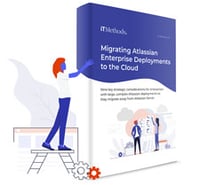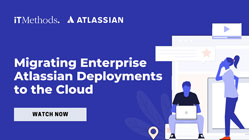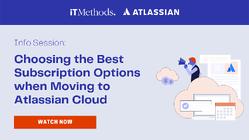If you haven’t heard yet, Atlassian is discontinuing its server offering as of February 15, 2024. This change reflects Atlassian’s increased focus on the cloud and the general industry trend away from data centers and towards cloud-based SaaS services.
 But for companies that depend on Atlassian products, this change can be alarming. It’s tempting to look at the end-of-support date and conclude that you don’t have to worry about it yet. But the migration process takes at least six months, so there is only so long that you can wait.
But for companies that depend on Atlassian products, this change can be alarming. It’s tempting to look at the end-of-support date and conclude that you don’t have to worry about it yet. But the migration process takes at least six months, so there is only so long that you can wait.
We wrote a whitepaper to address some of the common questions organizations have about the future of Atlassian server, what to do next and how to ensure the smoothest migration possible. Here are some of the key points:
You don’t have to move to Atlassian Cloud right now
Organizations also don’t have to move directly to Atlassian Cloud. For some, moving to Atlassian Data Center, either managed on-premises or as part of a managed service, is the best immediate step. This is especially true if there are functionality or compliance certifications that your organization needs that don’t appear on the Atlassian Cloud roadmap right now.
You should identify a strategy that fits your needs
The first part of any migration, whether directly to Atlassian Cloud or to Data Center on-premises or as a managed service, has to start with assessment and planning. This involves a thorough assessment of what products are being used throughout your organization, which add-ons you use, what types of integrations you need to support and what versions of Atlassian applications you’re running. You’ll also want to compare your needs to the Atlassian Cloud roadmap. You can’t develop a good migration strategy — or know whether or not waiting is a good idea — without doing this assessment.
Don’t focus exclusively on technology and neglect people
The migration to Atlassian Cloud will have broad-ranging impacts throughout the organization, on junior developers and senior executives. As a result, their input should be incorporated into the migration strategy and organizations should ensure buy-in from all stakeholders on the ultimate migration strategy. Relatedly, organizations shouldn’t overlook the importance of training, because the new user experience will be different and users need a way to get up to speed quickly.
Considering how to migrate your Atlassian Enterprise deployments to the Cloud? Watch our recent webinars to learn more:
 Migrating your Atlassian Applications to the Cloud? Are you on-premise or hosted today? Are you on Server and/or Data Center? Are you Self-Managed? You have options and iTMethods has you covered!
Migrating your Atlassian Applications to the Cloud? Are you on-premise or hosted today? Are you on Server and/or Data Center? Are you Self-Managed? You have options and iTMethods has you covered!
 Which Atlassian Cloud plan is right for you? Between Standard, Premium or Enterprise plans to choose from - how will you decide what best fits your team's needs?
Which Atlassian Cloud plan is right for you? Between Standard, Premium or Enterprise plans to choose from - how will you decide what best fits your team's needs?
About iTMethods
We are an Atlassian Enterprise Gold Partner and authorized MSP specializing in Atlassian Cloud and Migration solutions. Successfully operating for over 15 years, we are also a market leader in enabling Enterprise DevOps. Our proprietary Managed DevOps SaaS Platform enables companies to integrate, migrate, and modernize their multi-vendor, multi-cloud toolchain so they can build better software, faster and more securely.
Our capabilities include supporting 45+ DevOps tools from leading vendors such as Atlassian, CloudBees/Jenkins, GitHub, SonarSource, GitLab, and many more. These tools are deployed to each customer’s specific requirements, including security, scalability, and 24/7 customer support.
Learn more at www.itmethods.com
Read more from iTMethods: